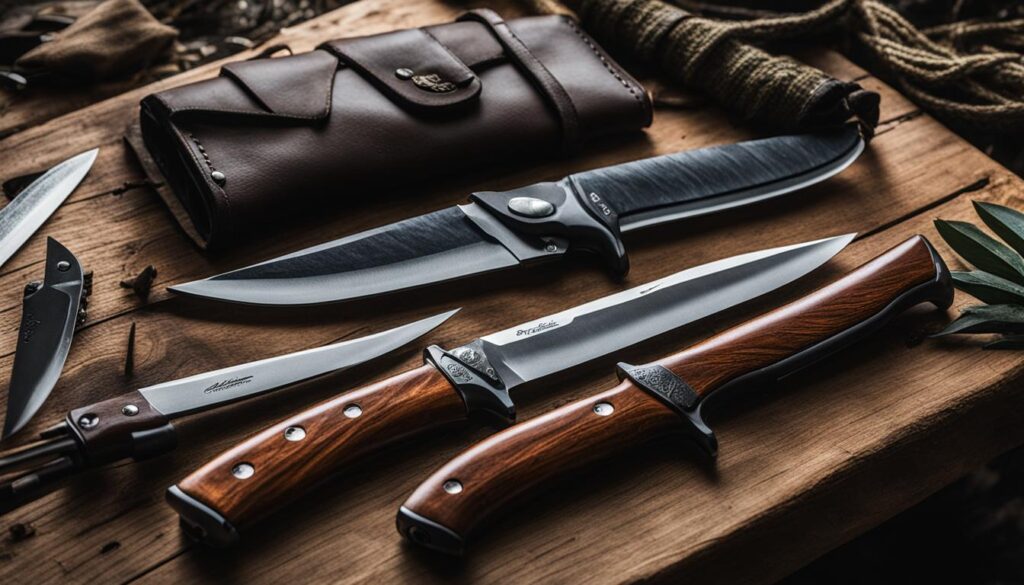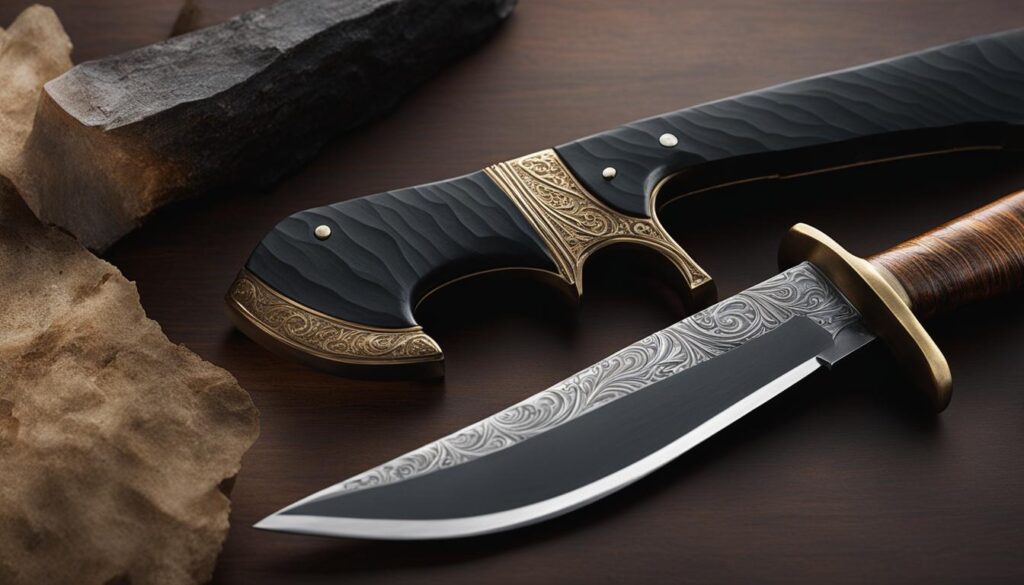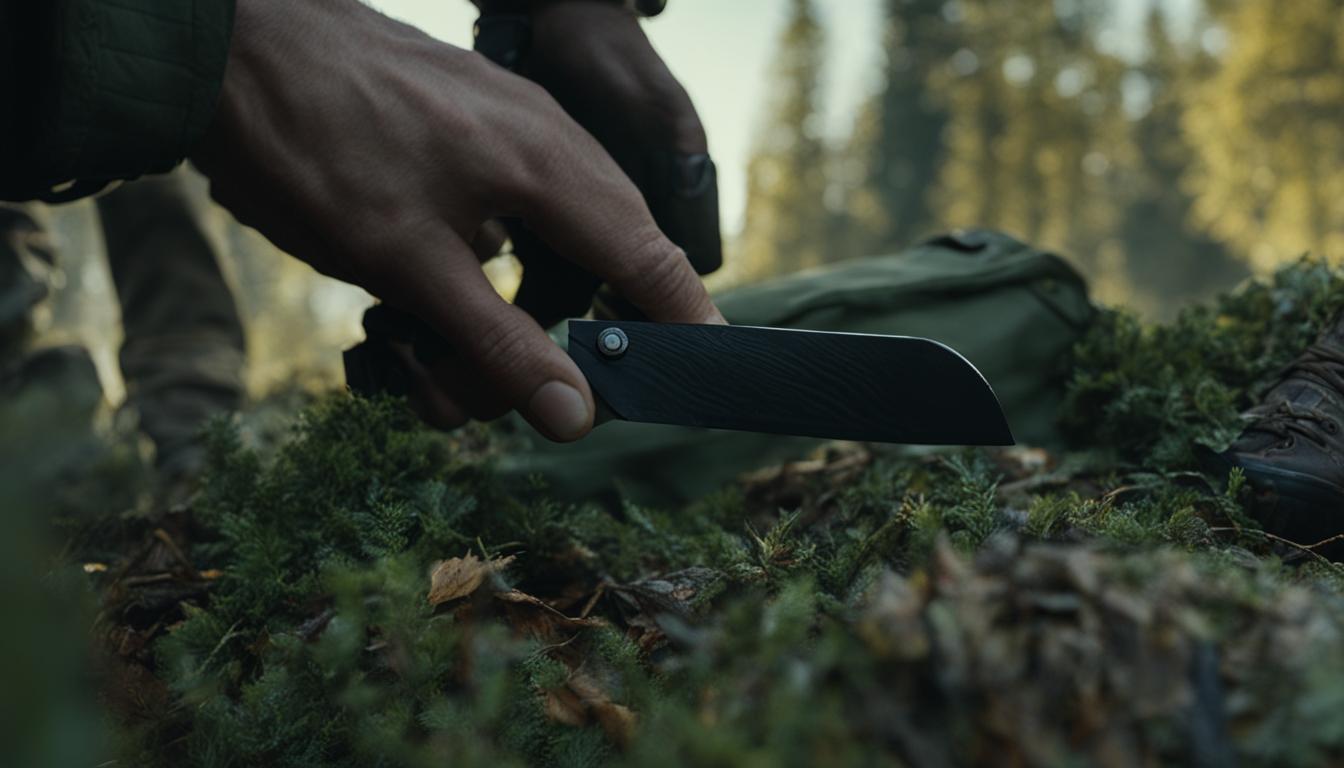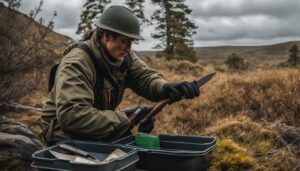When it comes to embarking on outdoor adventures, having the right tools is crucial. For hunting enthusiasts, a reliable and sharp hunting knife is an essential companion. But how do you ensure the safe transport of your prized knives? In this guide, I will share expert tips and methods for securely transporting your hunting knives, ensuring both your safety and the longevity of your equipment.
Key Takeaways:
- Inspect and clean your knives before packing them for outdoor trips.
- Select the appropriate knives for your needs, such as folding knives or fixed-blade knives.
- Pack your knives securely in a knife roll or case.
- Familiarize yourself with any knife-carrying restrictions when traveling by plane or public transportation.
- Keep your knives stored in a safe and secure location at your campsite.
Types of Outdoor Knives for Hunting and Survival
When it comes to outdoor adventures, having the right knife can make all the difference. There are various types of outdoor knives designed for specific purposes. Let’s take a closer look at some of the most common types:
Fixed-Blade Knives
Fixed-blade knives are known for their durability and strength. They are ideal for hunting, survival situations, and demanding outdoor tasks. With a fixed blade that extends through the handle, these knives offer stability and reliability.
Hunting Knives
Hunting knives are specifically designed for hunters. They typically have a sharp, curved blade that is perfect for skinning and field dressing game. Hunting knives come in various sizes and styles to accommodate different hunting needs.
Survival Knives
Survival knives are multifunctional tools that are essential for outdoor enthusiasts. These knives often feature additional features such as sawing edges, fire starters, or even compasses. They are designed to handle a wide range of tasks and are built to withstand harsh conditions.
Folding Knives
Folding knives are compact and portable, making them ideal for everyday carry. These knives have a folding mechanism that allows the blade to be safely stored inside the handle when not in use. They are versatile and come in various sizes and designs.
Other types of outdoor knives include EDC (Everyday Carry) knives, which are lightweight and designed for daily tasks, and multi-tool knives, which combine a knife with other essential tools. Fishing knives, particularly fillet knives, are specialized for cleaning and preparing fish.
| Type | Description |
|---|---|
| Fixed-Blade Knives | Durable and sturdy knives for hunting and demanding outdoor tasks. |
| Hunting Knives | Sharp curved blades for skinning and field dressing game. |
| Survival Knives | Versatile tools with additional features for various tasks. |
| Folding Knives | Compact and portable knives with folding mechanisms. |
| EDC Knives | Lightweight knives designed for everyday tasks. |
| Multi-Tool Knives | Knives that combine a blade with other essential tools. |
| Fishing Knives | Specialized knives for cleaning and preparing fish. |
| Fillet Knives | Knives specifically designed for filleting fish. |
Factors to Consider for Choosing the Right Outdoor Knife
When selecting an outdoor knife, several factors should be taken into consideration to ensure that you choose the right tool for your specific needs. These factors include the purpose of the knife, size and weight, blade material, handle material, and budget. By carefully considering each of these elements, you can make an informed decision and find a knife that meets your requirements.
Purpose
The first factor to consider is the purpose for which you will be using the knife. Are you looking for a knife primarily for hunting and survival situations, or do you need a versatile tool for everyday use? Understanding the intended purpose will help you determine the appropriate blade length, shape, and type.
Size and Weight
The size and weight of the knife are crucial for both portability and ease of use. Depending on your needs, you may prefer a compact and lightweight knife that can be easily carried in your pocket or backpack. Alternatively, if you require a more robust tool for heavy-duty tasks, a larger and heavier knife may be more suitable.
Blade Material
The blade material plays a significant role in the performance and durability of the knife. Common blade materials include stainless steel, high-carbon steel, and various alloy combinations. Stainless steel blades are known for their corrosion resistance, while high-carbon steel blades offer excellent sharpness and edge retention. Consider the pros and cons of each blade material and choose one that aligns with your specific requirements.
Handle Material
The handle material is equally important as it affects the comfort, grip, and overall durability of the knife. Common handle materials include wood, rubber, G-10, and various synthetic composites. Different handle materials offer different levels of grip, comfort, and resistance to moisture and impact. Consider your personal preferences and the conditions in which you will be using the knife to select the most suitable handle material.
Budget
Your budget is another essential factor to consider when choosing an outdoor knife. Prices for knives can vary significantly depending on the brand, materials used, and additional features. Set a budget that is within your means and explore options within that range. Remember that a higher price doesn’t always guarantee better quality, so it’s essential to balance your budget with the other factors mentioned above.
By considering these factors – purpose, size and weight, blade material, handle material, and budget – you can confidently choose the right outdoor knife that meets your needs and preferences. Keep in mind that there is no one-size-fits-all solution, and what works for one person may not work for another. It’s important to prioritize your requirements and find a knife that suits your specific outdoor activities.
Maintaining and Caring for Your Outdoor Knife
Cleaning, sharpening, lubrication, storage, and routine inspection are essential for maintaining and caring for your outdoor knife. By following these practices, you can ensure that your knife remains in optimal condition and functions effectively when you need it most.
Cleaning
After each use, it is important to clean your outdoor knife to remove dirt, debris, and any potential corrosive substances. Use warm water and mild soap to gently clean the blade, handle, and any other parts of the knife. Avoid using abrasive cleaners or harsh chemicals that could damage the knife’s materials. Once cleaned, thoroughly dry the knife to prevent moisture-related issues such as rust.
Sharpening
Regular sharpening is necessary to maintain a sharp and functional blade. There are various methods and tools available for sharpening knives, including sharpening stones, honing rods, and guided sharpening systems. Choose the method that works best for you and follow the manufacturer’s instructions. Take care not to over-sharpen the blade, as this can lead to excessive wear.
Lubrication
Lubricating the moving parts of folding knives is important to ensure smooth operation and prevent rust. Apply a small amount of lubricant, such as knife oil or lubricating wax, to pivot points, springs, and any other areas that require lubrication. Be sure to use a lubricant specifically designed for knives, as other household lubricants may cause damage.
Storage
Proper storage is crucial for protecting your outdoor knife when it is not in use. Store your knife in a dry, cool place to prevent moisture buildup and minimize the chances of rust. Consider using a knife sheath, blade guard, or knife roll to provide additional protection against accidental damage. Avoid storing your knife in a way that it can come into contact with other metal objects, as this can cause nicks or scratches.
Routine Inspection
Regularly inspect your outdoor knife for any signs of wear, damage, or rust. Check the blade for any chips, dents, or corrosion, and examine the handle for cracks or loose components. If you notice any issues, address them promptly to prevent further damage. Routine inspection allows you to identify and resolve minor problems before they become more significant.
By incorporating cleaning, sharpening, lubrication, storage, and routine inspection into your knife maintenance routine, you can ensure that your outdoor knife remains in optimal condition for years to come.
Further Developing Your Knife Skills and Knowledge
Developing your knife skills and knowledge is essential for outdoor enthusiasts who want to make the most of their knives. By honing your skills and expanding your knowledge, you can become more proficient at various outdoor tasks and enhance your overall experience. Here are some ways to further develop your knife skills and knowledge:
Knife Skills Workshops
Attending knife skills workshops is a great way to improve your technique and learn new skills. These workshops are typically led by experienced instructors who can teach you proper knife handling, cutting techniques, and safety protocols. You’ll have the opportunity to practice your skills under expert guidance and receive valuable feedback. Knife skills workshops are available at outdoor schools, culinary institutes, and even online platforms.
Outdoor Survival Courses
Enrolling in outdoor survival courses can provide you with essential wilderness skills that go hand in hand with knife use. These courses cover a wide range of topics, including shelter building, fire making, navigation, and first aid. Understanding these skills will not only enhance your knife skills but also ensure your safety and well-being in outdoor environments. Look for reputable outdoor schools or certified instructors who offer comprehensive survival courses.
Connecting with the Knife Community
Engaging with the knife community is an excellent way to connect with like-minded individuals who share your interest in knives. Join online forums, social media groups, or local meetups to interact with fellow enthusiasts. You can exchange knowledge, seek advice, and stay up-to-date with the latest trends and advancements in knife technology. Connecting with the knife community will enable you to broaden your perspectives and discover new opportunities to learn and grow.
Customization Options
Customizing your knife allows you to personalize it according to your preferences and needs. Many knife manufacturers offer customization options, such as choosing different handle materials, blade finishes, or even adding personalized engravings. Exploring these options and making your knife unique can enhance your connection with it and make it a cherished tool in your collection.
Expanding Your Collection
Expanding your knife collection can introduce you to different types of knives and their specific uses. Each knife has its own strengths and advantages, and having a diverse collection can provide you with the right tool for various tasks. Consider adding knives that cater to different outdoor activities, such as camping, hunting, or fishing. Exploring different knives will not only increase your knowledge but also enable you to tackle a wide range of outdoor challenges with confidence.

| Benefits | Details |
|---|---|
| Enhanced Technique | Learn proper knife handling and cutting techniques. |
| Expanded Skill Set | Acquire new skills that complement knife use. |
| Community Engagement | Connect with like-minded individuals and share knowledge. |
| Personalization | Customize your knife to match your preferences. |
| Versatility | Expand your collection for different outdoor activities. |
Exploring the History and Evolution of Knives
Knives have a rich and fascinating history that spans thousands of years. From their humble origins as simple cutting tools to the intricate designs and specialized functions we see today, the development of knives showcases the ingenuity and adaptability of human civilization.
The earliest known knives date back to the Stone Age, where they were crafted from sharp flakes of obsidian or flint. These primitive blades were vital for survival, allowing our ancestors to hunt, prepare food, and protect themselves. Over time, as metalworking techniques advanced, knives evolved into more sophisticated tools.


| Period | Key Features |
|---|---|
| Bronze Age | The introduction of bronze blades increased durability and allowed for more intricate designs. |
| Iron Age | Iron blades became more prevalent, offering even greater strength and sharpness. |
| Middle Ages | Knives were often ornately decorated and served as symbols of wealth and status. |
| Industrial Revolution | The mass production of knives made them more accessible to the general population. |
| Modern Era | Advancements in materials, such as stainless steel and ceramic, have further enhanced knife performance and durability. |
Today, we have a wide variety of knives designed for specific tasks, including hunting, survival, cooking, and everyday use. Each knife type incorporates unique features and materials tailored to its intended purpose. From the rugged fixed-blade hunting knives of the past to the sleek and versatile folding knives of the present, the evolution of knives continues to meet the ever-changing needs of individuals.
Knife Safety Rules to Never Forget
When it comes to handling knives, safety should always be a top priority. By following a few fundamental knife safety rules, you can significantly reduce the risk of accidents and injuries. Whether you’re an outdoor enthusiast or simply using a knife in your daily life, these guidelines should never be forgotten.
First and foremost, it’s crucial to avoid what is commonly known as the “triangle of death.” This refers to the area formed by your face, nipples, and groin. When using a knife, always make sure that you keep these vital parts of your body clear of the knife’s path. By maintaining distance from the triangle of death, you can minimize the chances of severe injuries in case of accidental slips or mishaps.
Another important rule is to always cut away from your body. It may seem like common sense, but accidents can happen when people forget this basic principle. By keeping the blade pointed away from your body and directing the cutting motion away from yourself, you reduce the risk of accidentally cutting yourself. Remember, it’s better to be safe than sorry.
Knife Handling Rules
- Keep your fingers behind the blade when using a knife.
- Never leave an unsecured knife lying around.
- Exercise caution when using a knife while impaired.
Lastly, never leave a knife unsecured or lying around. After using a knife, always make sure to store it in a safe and secure location. This not only helps prevent accidents but also ensures that the knife remains in good condition for future use.
Remember that knife safety is not only about protecting yourself but also about respecting the potential danger that knives possess. By following these essential knife safety rules, you can enjoy working with knives while minimizing the risk of harm.
| Knife Safety Rules | Explanation |
|---|---|
| Avoid the “triangle of death” | Keep your face, nipples, and groin clear of the knife’s path to prevent severe injuries. |
| Cut away from your body | Always direct the cutting motion away from yourself to reduce the risk of accidental cuts. |
| Keep fingers behind the blade | Ensure your fingers are safely positioned behind the knife’s blade for added protection. |
| Never leave an unsecured knife lying around | Store your knife in a secure location to prevent accidents and maintain its condition. |
| Exercise caution when using a knife while impaired | Avoid using a knife if you are impaired, as it can increase the risk of accidents. |
Conclusion
Safely transporting hunting knives is essential for outdoor enthusiasts. By following proper packing techniques, selecting the right knives, and maintaining them, you can ensure a safe and enjoyable outdoor experience. Continuously developing your knife skills and knowledge will allow you to fully appreciate the versatility and history of knives. Always prioritize knife safety to prevent accidents and injuries.
When packing your knives for camping or any outdoor activity, it is crucial to inspect and clean them beforehand. Choose the appropriate knives for your specific needs, whether it’s pocket knives, folding knives, or fixed-blade knives. Pack your knives securely in a knife roll or case to prevent any accidents or damage during transportation.
Furthermore, it’s important to be aware of any restrictions on carrying knives when traveling by plane or public transportation. Always store your knives in a safe and secure location at the campsite or wherever you are staying. This will ensure that they are not easily accessible to anyone who shouldn’t handle them and prevent any potential accidents or injuries.
Remember, knife safety should always be a top priority. By following these guidelines and adopting responsible knife handling practices, you can enjoy the great outdoors with confidence, knowing that you are taking the necessary precautions to stay safe. So, grab your knives, embark on your outdoor adventures, and embrace the incredible world of blades and their rich history!
FAQ
How should I clean my outdoor knife after use?
Clean your outdoor knife with warm water and soap after each use to remove any dirt or debris. Dry it thoroughly before storing it to prevent rust.
How often should I sharpen the blade of my outdoor knife?
It is recommended to sharpen the blade of your outdoor knife regularly, depending on how often you use it. Use appropriate sharpening tools and techniques to maintain a sharp and effective blade.
What should I use to lubricate the moving parts of my folding knife?
To ensure smooth operation, use a lubricant specifically designed for knives. Apply a small amount to the pivot point and other moving parts of the folding knife.
Where should I store my outdoor knife when not in use?
Store your outdoor knife in a dry and cool place to prevent moisture and corrosion. Ensure it is stored securely to avoid accidents or unauthorized access.
How can I improve my knife skills?
Consider attending knife skills workshops or courses to learn proper techniques and enhance your skills. You can also connect with the online knife community for advice, support, and discussions.
What are some customization options for my outdoor knife?
Depending on the knife, you may have various customization options such as engraving, adding personalized handles, or choosing different blade finishes. Explore options from reputable knife customization services.
What are some essential knife safety rules to follow?
Always cut away from your body and keep your fingers behind the blade. Never leave an unsecured knife lying around and exercise caution when using a knife while impaired.





